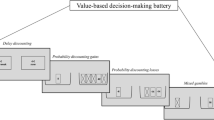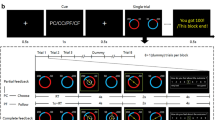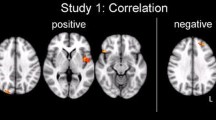Abstract
Inter-temporal decision-making is ubiquitous in daily life and has been considered as a critical characteristic associated with an individual’s success. Such decisions require us to tradeoff between short-term and long-term benefits. Prior studies have indicated that inter-temporal decision involves various brain regions that tend to occupy the central hubs. However, it is unclear whether the functional connectivities among hub as well as non-hub regions can predict discounting behaviors. Here, we combined with graph-theoretical algorithm and multivariate pattern analysis to explore whether voxel-wise functional connectivity strength in the whole brain could predict discounting rates (indexed as logk, based on the adaptive delay-discounting task) in a relatively large sample (n = 429) of young adults. Results revealed that short- and long-distance as well as all-range non-hub functional connectivity strength in the limbic system (i.e., medial orbitofrontal cortex and parahippocampus) were inversely associated with discounting rates. Furthermore, these results were robust and did not appear to be due to potential confounding factors. Above weight-based degree metric is commonly indicative of the communication pattern of local and global parallel information processing, and it therefore provides novel insights into the neural mechanisms underlying inter-temporal decision-making from the perspective of human brain topological organizations.




Similar content being viewed by others
References
Achard, S., Salvador, R., Whitcher, B., Suckling, J., & Bullmore, E. (2006). A resilient, low-frequency, small-world human brain functional network with highly connected association cortical hubs. The Journal of Neuroscience, 16(1), 63–72.
Alessi, S., & Petry, N. M. (2003). Pathological gambling severity is associated with impulsivity in a delay discounting procedure. Behavioural Processes, 64(3), 345–354.
Beasley, T. M., Erickson, S., & Allison, D. B. (2009). Rank-based inverse normal transformations are increasingly used, but are they merited? Behavior Genetics, 39(5), 580–595.
Bechara, A., & Damasio, A. R. (2005). The somatic marker hypothesis: A neural theory of economic decision. Games and Economic Behavior, 52(2), 336–372.
Berns, G. S., Laibson, D., & Loewenstein, G. (2007). Intertemporal choice–toward an integrative framework. Trends in Cognitive Sciences, 11(11), 482–488.
Bickel, W. K., Odum, A. L., & Madden, G. J. (1999). Impulsivity and cigarette smoking: Delay discounting in current, never, and ex-smokers. Psychopharmacology, 146(4), 447–454.
Bludau, S., Eickhoff, S. B., Mohlberg, H., Caspers, S., Laird, A. R., Fox, P. T., Schleicher, A., Zilles, K., & Amunts, K. (2014). Cytoarchitecture, probability maps and functions of the human frontal pole. Neuroimage, 93, 260–275.
Bondy, J. A., & Murty, U. S. R. (1976). Graph theory with applications (Vol. 290): Macmillan London.
Buckner, R. L., Sepulcre, J., Talukdar, T., Krienen, F. M., Liu, H., Hedden, T., Andrews-Hanna, J. R., Sperling, R. A., & Johnson, K. A. (2009). Cortical hubs revealed by intrinsic functional connectivity: Mapping, assessment of stability, and relation to Alzheimer's disease. Journal of Neuroscience, 29(6), 1860–1873.
Bullmore, E., & Sporns, O. (2009). Complex brain networks: Graph theoretical analysis of structural and functional systems. Nature Reviews Neuroscience, 10(3), 186–198.
Burgess, P. W., Scott, S. K., & Frith, C. D. (2003). The role of the rostral frontal cortex (area 10) in prospective memory: A lateral versus medial dissociation. Neuropsychologia, 41(8), 906–918.
Cai, H., Chen, J., Liu, S., Zhu, J., & Yu, Y. (2020). Brain functional connectome-based prediction of individual decision impulsivity. cortex, 125, 288–298.
Chen, Z., Guo, Y., & Feng, T. (2017). Delay discounting is predicted by scale-free dynamics of default mode network and salience network. Neuroscience, 362, 219–227.
Chen, Z., Guo, Y., Zhang, S., & Feng, T. (2019a). Pattern classification differentiates decision of intertemporal choices using multi-voxel pattern analysis. cortex, 111, 183–195.
Chen, Z., Hu, X., Chen, Q., & Feng, T. (2019b). Altered structural and functional brain network overall organization predict human intertemporal decision-making. Human Brain Mapping, 40(1), 306–328.
Clithero, J. A., Carter, R. M., & Huettel, S. A. (2009). Local pattern classification differentiates processes of economic valuation. Neuroimage, 45(4), 1329–1338.
Cole, M. W., Reynolds, J. R., Power, J. D., Repovs, G., Anticevic, A., & Braver, T. S. (2013). Multi-task connectivity reveals flexible hubs for adaptive task control. Nature Neuroscience, 16(9), 1348–1355.
Cox, D. D., & Savoy, R. L. (2003). Functional magnetic resonance imaging (fMRI) "brain reading": Detecting and classifying distributed patterns of fMRI activity in human visual cortex. Neuroimage, 19(2), 261–270.
Damoiseaux, J., Rombouts, S., Barkhof, F., Scheltens, P., Stam, C., Smith, S. M., et al. (2006). Consistent resting-state networks across healthy subjects. Proceedings of the National Academy of Sciences, 103(37), 13848–13853.
de Reus, M. A., & Van den Heuvel, M. P. (2013). The parcellation-based connectome: Limitations and extensions. Neuroimage, 80, 397–404.
Dombrovski, A. Y., Siegle, G. J., Szanto, K., Clark, L., Reynolds, C., & Aizenstein, H. (2012). The temptation of suicide: Striatal gray matter, discounting of delayed rewards, and suicide attempts in late-life depression. Psychological Medicine, 42(6), 1203–1215.
Douw, L., Baayen, H., Bosma, I., Klein, M., Vandertop, P., Heimans, J., Stam, K., de Munck, J., & Reijneveld, J. (2008). Treatment-related changes in functional connectivity in brain tumor patients: A magnetoencephalography study. Experimental Neurology, 212(2), 285–290.
Drucker, H., Burges, C. J., Kaufman, L., Smola, A. J., & Vapnik, V. (1997). Support vector regression machines. Paper presented at the Advances in neural information processing systems.
Eklund, A., Nichols, T. E., & Knutsson, H. (2016). Cluster failure: why fMRI inferences for spatial extent have inflated false-positive rates. Proceedings of the National Academy of Sciences, 201602413.
Fox, M. D., Snyder, A. Z., Vincent, J. L., Corbetta, M., Van Essen, D. C., & Raichle, M. E. (2005). The human brain is intrinsically organized into dynamic, anticorrelated functional networks. Proceedings of the National Academy of Sciences, 102(27), 9673–9678.
Franzmeier, N., Düzel, E., Jessen, F., Buerger, K., Levin, J., Duering, M., Dichgans, M., Haass, C., Suárez-Calvet, M., Fagan, A. M., Paumier, K., Benzinger, T., Masters, C. L., Morris, J. C., Perneczky, R., Janowitz, D., Catak, C., Wolfsgruber, S., Wagner, M., Teipel, S., Kilimann, I., Ramirez, A., Rossor, M., Jucker, M., Chhatwal, J., Spottke, A., Boecker, H., Brosseron, F., Falkai, P., Fliessbach, K., Heneka, M. T., Laske, C., Nestor, P., Peters, O., Fuentes, M., Menne, F., Priller, J., Spruth, E. J., Franke, C., Schneider, A., Kofler, B., Westerteicher, C., Speck, O., Wiltfang, J., Bartels, C., Araque Caballero, M. Á., Metzger, C., Bittner, D., Weiner, M., Lee, J. H., Salloway, S., Danek, A., Goate, A., Schofield, P. R., Bateman, R. J., & Ewers, M. (2018). Left frontal hub connectivity delays cognitive impairment in autosomal-dominant and sporadic Alzheimer’s disease. Brain, 141(4), 1186–1200.
Freeman, L. C., Borgatti, S. P., & White, D. R. (1991). Centrality in valued graphs: A measure of betweenness based on network flow. Social Networks, 13(2), 141–154.
Hagmann, P., Cammoun, L., Gigandet, X., Meuli, R., Honey, C. J., Wedeen, V. J., & Sporns, O. (2008). Mapping the structural core of human cerebral cortex. PLoS Biology, 6(7), e159.
Haxby, J. V. (2012). Multivariate pattern analysis of fMRI: The early beginnings. Neuroimage, 62(2), 852–855.
Haxby, J. V., Connolly, A. C., & Guntupalli, J. S. (2014). Decoding neural representational spaces using multivariate pattern analysis. Annual Review of Neuroscience, 37, 435–456.
He, Q., Xue, G., Chen, C., Chen, C., Lu, Z.-L., & Dong, Q. (2013). Decoding the neuroanatomical basis of reading ability: A multivoxel morphometric study. Journal of Neuroscience, 33(31), 12835–12843.
He, Y., Chen, Z., & Evans, A. (2007). Small-world anatomical networks in the human brain revealed by cortical thickness from MRI. Cerebral Cortex, 17(10), 2407–2419.
Hu, S., Ide, J. S., Zhang, S., Sinha, R., & Chiang-shan, R. L. (2015). Conflict anticipation in alcohol dependence—A model-based fMRI study of stop signal task. Neuroimage: Clinical, 8, 39–50.
Iturria-Medina, Y., Sotero, R. C., Canales-Rodríguez, E. J., Alemán-Gómez, Y., & Melie-García, L. (2008). Studying the human brain anatomical network via diffusion-weighted MRI and graph theory. Neuroimage, 40(3), 1064–1076.
Jimura, K., & Poldrack, R. A. (2012). Analyses of regional-average activation and multivoxel pattern information tell complementary stories. Neuropsychologia, 50(4), 544–552.
Johnson, M. W., & Bickel, W. K. (2002). Within-subject comparison of real and hypothetical money rewards in delay discounting. Journal of the Experimental Analysis of Behavior, 77(2), 129–146.
Kriegeskorte, N., Goebel, R., & Bandettini, P. (2006). Information-based functional brain mapping. Proceedings of the National Academy of Sciences, 103(10), 3863–3868.
Kringelbach, M. L. (2005). The human orbitofrontal cortex: Linking reward to hedonic experience. Nature Reviews Neuroscience, 6(9), 691–702.
Lempert, K. M., & Phelps, E. A. (2016). The malleability of intertemporal choice. Trends in Cognitive Sciences, 20(1), 64–74.
Li, N., Ma, N., Liu, Y., He, X.-S., Sun, D.-L., Fu, X.-M., Zhang, X., Han, S., & Zhang, D. R. (2013). Resting-state functional connectivity predicts impulsivity in economic decision-making. Journal of Neuroscience, 33(11), 4886–4895.
Liang, X., Zou, Q., He, Y., & Yang, Y. (2013). Coupling of functional connectivity and regional cerebral blood flow reveals a physiological basis for network hubs of the human brain. Proceedings of the National Academy of Sciences, 110(5), 1929–1934.
Liu, H., Qin, W., Li, W., Fan, L., Wang, J., Jiang, T., & Yu, C. (2013). Connectivity-based parcellation of the human frontal pole with diffusion tensor imaging. Journal of Neuroscience, 33(16), 6782–6790.
Liu, J., Xia, M., Dai, Z., Wang, X., Liao, X., Bi, Y., et al. (2017). Intrinsic brain hub connectivity underlies individual differences in spatial working memory. Cerebral Cortex, 27(12), 5496–5508.
Liu, Y., Yu, C., Zhang, X., Liu, J., Duan, Y., Alexander-Bloch, A. F., Liu, B., Jiang, T., & Bullmore, E. (2014). Impaired long distance functional connectivity and weighted network architecture in Alzheimer's disease. Cerebral Cortex, 24(6), 1422–1435.
Lv, C., Wang, Q., Chen, C., Qiu, J., Xue, G., & He, Q. (2019). The regional homogeneity patterns of the dorsal medial prefrontal cortex predict individual differences in decision impulsivity. Neuroimage, 200, 556–561.
Lv, C., Wang, Q., Chen, C., Xue, G., & He, Q. (2020). Activation patterns of the dorsal medial prefrontal cortex and frontal pole predict individual differences in decision impulsivity. Brain Imaging and Behavior In press.
Mariano, T., Bannerman, D., McHugh, S., Preston, T., Rudebeck, P., Rudebeck, S., et al. (2009). Impulsive choice in hippocampal but not orbitofrontal cortex-lesioned rats on a nonspatial decision-making maze task. European Journal of Neuroscience, 30(3), 472–484.
McClure, S. M., Ericson, K. M., Laibson, D. I., Loewenstein, G., & Cohen, J. D. (2007). Time discounting for primary rewards. Journal of Neuroscience, 27(21), 5796–5804.
McClure, S. M., Laibson, D. I., Loewenstein, G., & Cohen, J. D. (2004). Separate neural systems value immediate and delayed monetary rewards. Science, 306(5695), 503–507.
McNamee, D., Rangel, A., & O'doherty, J. P. (2013). Category-dependent and category-independent goal-value codes in human ventromedial prefrontal cortex. Nature Neuroscience, 16(4), 479–485.
Mobini, S., Body, S., Ho, M.-Y., Bradshaw, C., Szabadi, E., Deakin, J., & Anderson, I. M. (2002). Effects of lesions of the orbitofrontal cortex on sensitivity to delayed and probabilistic reinforcement. Psychopharmacology, 160(3), 290–298.
Norman, K. A., Polyn, S. M., Detre, G. J., & Haxby, J. V. (2006). Beyond mind-reading: Multi-voxel pattern analysis of fMRI data. Trends in Cognitive Sciences, 10(9), 424–430.
Oldham, S., & Fornito, A. (2019). The development of brain network hubs. Developmental Cognitive Neuroscience, 36, 100607.
Öngür, D., Ferry, A. T., & Price, J. L. (2003). Architectonic subdivision of the human orbital and medial prefrontal cortex. Journal of Comparative Neurology, 460(3), 425–449.
Paloyelis, Y., Asherson, P., Mehta, M. A., Faraone, S. V., & Kuntsi, J. (2010). DAT1 and COMT effects on delay discounting and trait impulsivity in male adolescents with attention deficit/hyperactivity disorder and healthy controls. Neuropsychopharmacology, 35(12), 2414–2426.
Peters, J., & Büchel, C. (2010). Episodic future thinking reduces reward delay discounting through an enhancement of prefrontal-mediotemporal interactions. Neuron, 66(1), 138–148.
Peters, J., & Büchel, C. (2011). The neural mechanisms of inter-temporal decision-making: Understanding variability. Trends in Cognitive Sciences, 15(5), 227–239.
Ramnani, N., & Owen, A. M. (2004). Anterior prefrontal cortex: Insights into function from anatomy and neuroimaging. Nature Reviews Neuroscience, 5(3), 184–194.
Rolls, E. T. (2004). The functions of the orbitofrontal cortex. Brain and Cognition, 55(1), 11–29.
Sasse, L. K., Peters, J., Büchel, C., & Brassen, S. (2015). Effects of prospective thinking on intertemporal choice: The role of familiarity. Human Brain Mapping, 36(10), 4210–4221.
Sellitto, M., Ciaramelli, E., & di Pellegrino, G. (2010). Myopic discounting of future rewards after medial orbitofrontal damage in humans. Journal of Neuroscience, 30(49), 16429–16436.
Shin, D.-J., Jung, W. H., He, Y., Wang, J., Shim, G., Byun, M. S., Jang, J. H., Kim, S. N., Lee, T. Y., Park, H. Y., & Kwon, J. S. (2014). The effects of pharmacological treatment on functional brain connectome in obsessive-compulsive disorder. Biological Psychiatry, 75(8), 606–614.
Shukla, D. K., Keehn, B., Smylie, D. M., & Müller, R.-A. (2011). Microstructural abnormalities of short-distance white matter tracts in autism spectrum disorder. Neuropsychologia, 49(5), 1378–1382.
Sporns, O. (2011). The human connectome: A complex network. Annals of the New York Academy of Sciences, 1224(1), 109–125.
Sporns, O., Honey, C. J., & Kotter, R. (2007). Identification and classification of hubs in brain networks. PLoS One, 2(10), e1049.
Tomasi, D., & Volkow, N. D. (2010). Functional connectivity density mapping. Proceedings of the National Academy of Sciences, 107(21), 9885–9890.
van den Bos, W., Rodriguez, C. A., Schweitzer, J. B., & McClure, S. M. (2014). Connectivity strength of dissociable striatal tracts predict individual differences in temporal discounting. Journal of Neuroscience, 34(31), 10298–10310.
Van Den Bos, W., Rodriguez, C. A., Schweitzer, J. B., & McClure, S. M. (2015a). Adolescent impatience decreases with increased frontostriatal connectivity. Proceedings of the National Academy of Sciences, 112(29), E3765–E3774.
Van Den Bos, W., Rodriguez, C. A., Schweitzer, J. B., & McClure, S. M. (2015b). Adolescent impatience decreases with increased frontostriatal connectivity. Proceedings of the National Academy of Sciences, 201423095.
van den Heuvel, M. P., & Sporns, O. (2013). Network hubs in the human brain. Trends in Cognitive Sciences, 17(12), 683–696.
Wang, Q., Chen, C., Cai, Y., Li, S., Zhao, X., Zheng, L., Zhang, H., Liu, J., Chen, C., & Xue, G. (2016). Dissociated neural substrates underlying impulsive choice and impulsive action. Neuroimage, 134, 540–549.
Wang, Q., Luo, S., Monterosso, J., Zhang, J., Fang, X., Dong, Q., & Xue, G. (2014a). Distributed value representation in the medial prefrontal cortex during intertemporal choices. Journal of Neuroscience, 34(22), 7522–7530.
Wang, X., Xia, M., Lai, Y., Dai, Z., Guo, Q., Cheng, Z., et al. (2014b). Disrupted resting-state functional connectivity in minimally treated chronic shiziphrenia. Schizophrenia Research, 156(2014), 150–156.
Yu, R. (2012). Regional white matter volumes correlate with delay discounting. PLoS One, 7(2), e32595.
Zha, R., Bu, J., Wei, Z., Han, L., Zhang, P., Ren, J., Li, J. A., Wang, Y., Yang, L., Vollstädt-Klein, S., & Zhang, X. (2019). Transforming brain signals related to value evaluation and self-control into behavioral choices. Human Brain Mapping, 40(4), 1049–1061.
Zhang, W., Li, S., Wang, X., Gong, Y., Yao, L., Xiao, Y., Liu, J., Keedy, S. K., Gong, Q., Sweeney, J. A., & Lui, S. (2018). Abnormal dynamic functional connectivity between speech and auditory areas in schizophrenia patients with auditory hallucinations. Neuroimage: Clinical, 19, 918–924.
Zuo, X.-N., Ehmke, R., Mennes, M., Imperati, D., Castellanos, F. X., Sporns, O., & Milham, M. P. (2011). Network centrality in the human functional connectome. Cerebral Cortex, 22(8), 1862–1875.
Acknowledgments
This work was supported by research grants from the Humanities and Social Science Fund Project of the Ministry of Education (20YJC190018), National Natural Science Foundation of China (31972906), and Entrepreneurship and Innovation Program for Chongqing Overseas Returned Scholars (cx2017049).
Author information
Authors and Affiliations
Corresponding authors
Ethics declarations
Conflict of interest
All authors declare no conflict of interest.
Ethical approval
All procedures performed in studies involving human participants were in accordance with the ethical standards of the Institutional Review Board (IRB) of the Southwest University and Beijing Normal University.
Informed consent
Informed consent was obtained from all participants or their parents included in the study.
Additional information
Publisher’s note
Springer Nature remains neutral with regard to jurisdictional claims in published maps and institutional affiliations.
Electronic supplementary material
ESM 1
(DOCX 6368 kb)
Rights and permissions
About this article
Cite this article
Wang, Q., Zhu, Y., Wang, Y. et al. Intrinsic non-hub connectivity predicts human inter-temporal decision-making. Brain Imaging and Behavior 15, 2005–2016 (2021). https://doi.org/10.1007/s11682-020-00395-3
Accepted:
Published:
Issue Date:
DOI: https://doi.org/10.1007/s11682-020-00395-3




